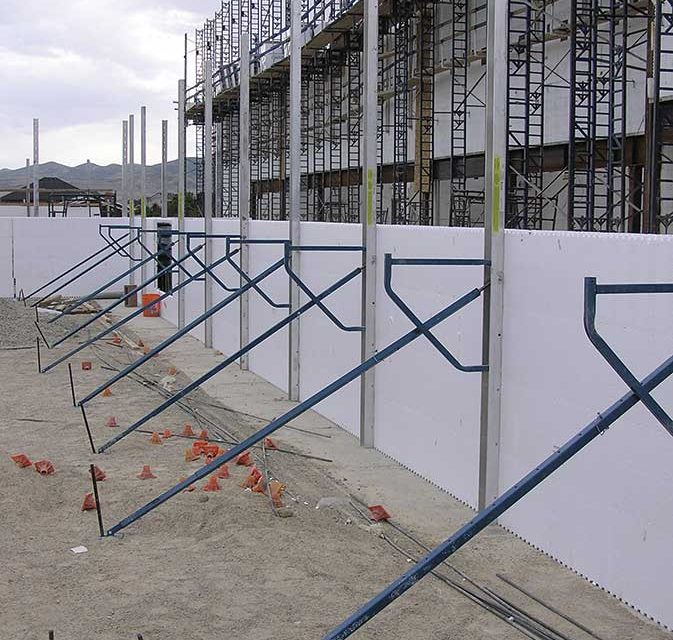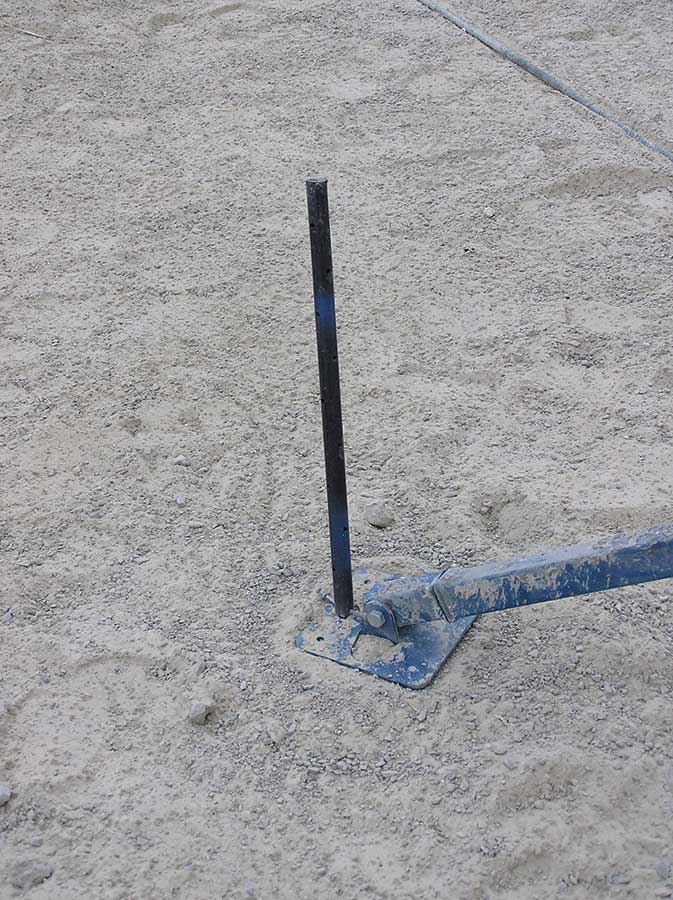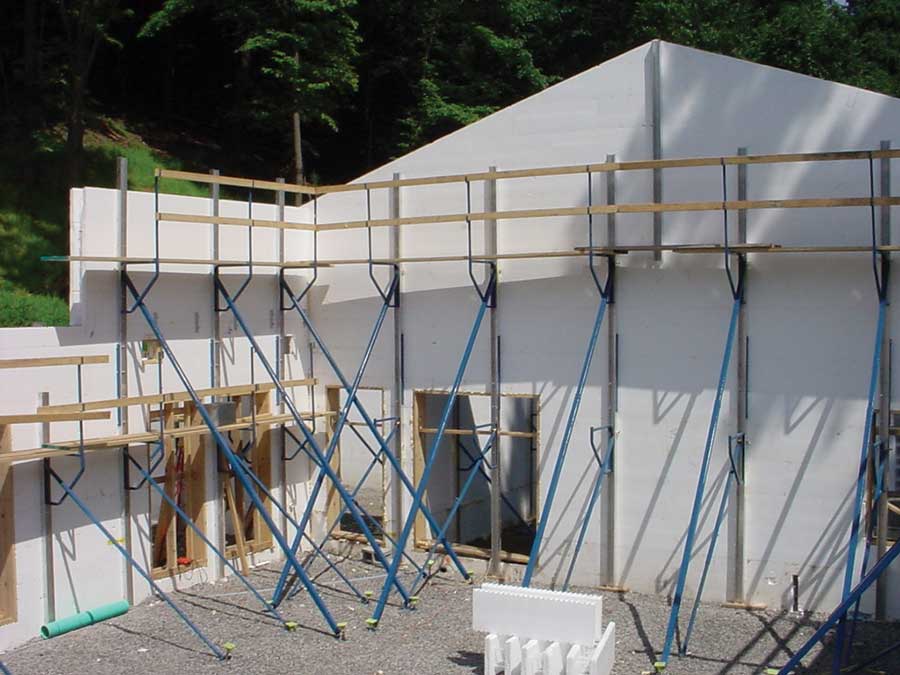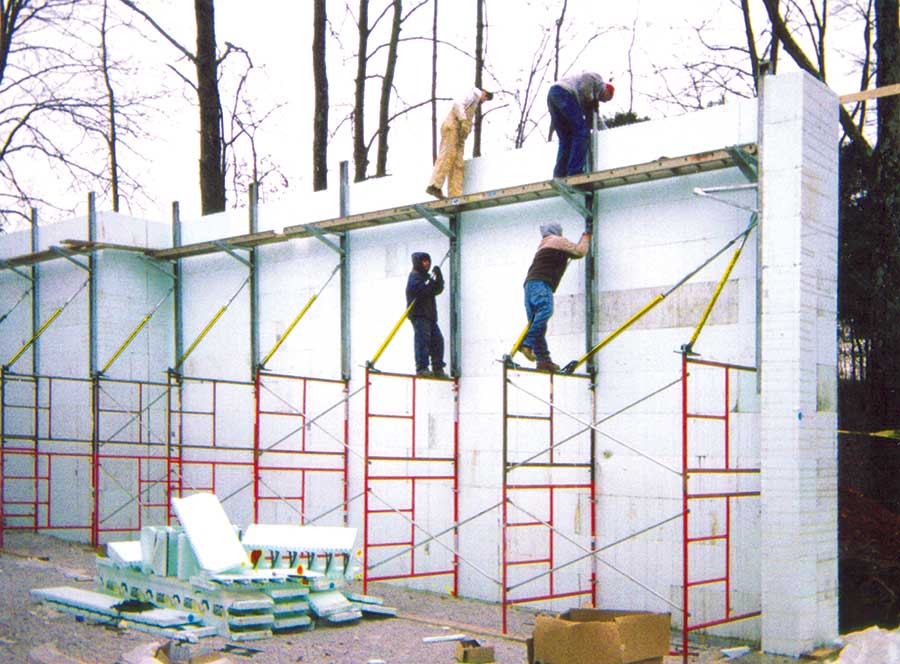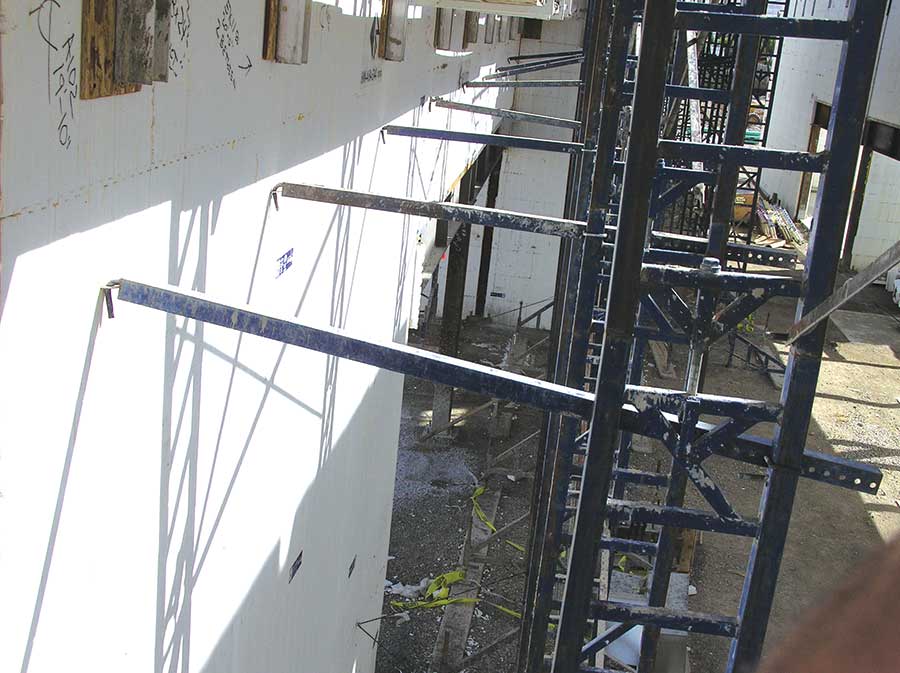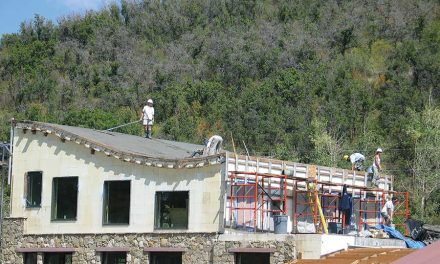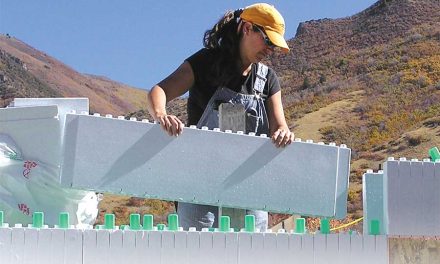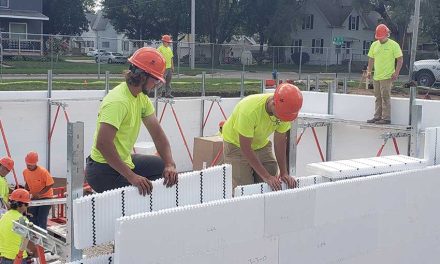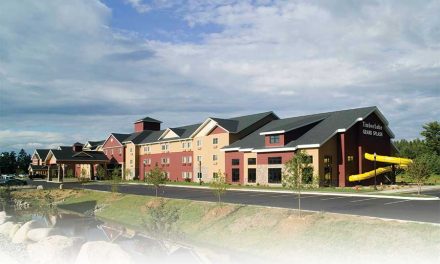No matter what your level of experience, bracing is an issue every ICF installer deals with on every job. And the higher the walls go, the more complicated it gets.
Yet by following a few simple guidelines, and knowing what equipment is available, just about any wall can be braced safely and easily.
General Rules
“Square and support your corners early in the build. Don’t wait until you’re six or seven courses high and scrambling to make your adjustments,” says Philip Constantini, an ICF construction consultant.
Usually, the bracing is attached after the first three courses are stacked, with one brace for every 5 or 6 feet of wall. “It’s engineered that way on a number of levels,” says Tom Sommerville, president of Plumwall, Ltd., “from the length of scaffolding plank to wind load requirements to concrete pressures.” Windows and doors need a brace on each edge, and corners and ‘T’s require additional bracing as well.
How much bracing does that add up to? Dan Kackman, sales director at Reechcraft, says, “A good rule of thumb is that with 32 units you can do a 1500 sq. ft. basement.”
Bracing is usually attached to the interior side of the walls. On below grade work, it’s often the only practical location. The building footprint also provides a flat, level place to stack, store, and assemble the braces.
“Your options are to build bracing using 2×4—which none of the manufacturers recommend—or to use some type of metal bracing system,” says Scott Crawford. Crawford rents bracing in the Colorado area to all types of ICF builders. Renting is becoming an increasingly popular alternative to purchasing your own—often expensive—set.
Use #10 or #12 self-tapping screws to attach the strongbacks to furring strips in the block. Some contractors use regular drywall screws, but Tom Patton, a technical director at Arxx Building Products, recommends using something heavier. Check with your block manufacturer for exact specifications.
Crawford offers another tip. “Put a screw in the center of the slot to allow for block compression.” Tighten the screw enough to keep the wall snug against the brace, but realize that the joint will need to slip when you adjust the wall.
Plumb the wall with a level, then stake the turnbuckle to the ground, or screw it securely to the subfloor. If a concrete slab with radiant heat is already in place, it’s a little more complicated. Patton recommends gluing a short length of 2×6 to the floor with construction adhesive, then fastening the shoe to the wood.
Before you pour your first lift, set a string line on the outside of the wall to ensure the wall is straight and plumb. Many contractors with adjustable metal bracing will pull the wall about ¼ inch inside of plumb just before pouring, knowing walls have a tendency to shift outward when filled with concrete. If it doesn’t, it’s a simple matter to push it to the string line with the turnbuckle.
An alternate method is to stretch a line from one corner strongback to the next to ensure every brace along the wall is in alignment.
Bracing Options
Of course, if you’re using wooden bracing, neither of those is an option. Be sure your braces are square, plumb and secure before you pour. It is virtually impossible, not to mention dangerous, to try and adjust a wooden brace once the wall is full of wet concrete.
Sommerville lists other reasons nearly all serious contractors have switched to metal bracing systems. “Wood warps in a number of directions and twists in the weather, so you’re starting the house with a warped wall. Any metal brace is going to be faster, quicker, and simpler. Bracing takes less than a day, and you end up with a better wall, because you have a good adjustment system.”
The turnbuckle adjustment system and integral scaffolding were pioneered by Reechcraft as the ICF industry was just gaining steam.
“We got into the business in 1999,” says Kackman. “We had other bracing products, but it wasn’t specific for ICFs. Manufacturers came to us looking to get jobsite quality up. After a few sketches on a napkin to get the concept right, we started with the Panel Jack. We’ve tweaked it over the years to make it easier for the contractor.”
Reechcraft bracing is available through a network of distributors, but can be purchased directly by the contractor as well. In a bind, they can “hot stamp” an order and have it shipped the next day. Reward and ECO-Block also market it as a private label product.
Arxx Building Products, perhaps the largest ICF manufacturer, produces its own brace. “It’s a heavier brace than competing products, and it works well with traditional scaffolding,” says Patton. “It’s also specifically designed to work with our block.” The company has more than 500 distributors in the U.S. and Canada, most of which have the braces in stock and available for rent.
Plumwall offers two styles of bracing for residential work, the “Classic,” which folds up conveniently and is available in lengths of 8, 10, and 12 feet, and the “Econobrace,” designed for the price-conscious contractor who only does a few jobs per year. Incidentally, Plumwall is the only company that offers a brace designed specifically for stem walls or frost walls less than four feet tall.
Mono-Brace, the newest entry in the market, is an ingenious self-contained system where everything—including the safety rails and pins—folds into the strongback. An additional bonus: all parts are attached to the frame.
“Your crew doesn’t arrive on the jobsite and realize that they’ve forgotten some piece of the system,” explains Jeff Bresler, chief marketing officer. “It also stacks better than some systems out there.”
The downside of folding systems is that they can get heavy. An 8-foot brace weighs 50 or 60 pounds. A 12-foot brace weighs 70 or 80.
In the last year or so, several companies have begun offering L-shaped strongbacks for corners to simplify a task that previously required two braces.
“Regardless of what system you use, the amount of time saved by a good bracing set is astronomical,” says Sommerville. “With labor costs the way they are, adjustable metal bracing is the only way to go.”
Tall Walls
As commercial ICF construction has become more popular—experts indicate it will grow 40 to 50 percent just this year—the question of how to brace walls over 20 feet tall has become more urgent.
Bracing companies have responded to the demand by creating new commercial systems, most created in the last year or two.
“Our message to the contractors is, ‘Don’t be afraid to bid the big jobs, ‘cause we’ve got your back.,’” says Kackman.
The most common method is to stack and brace the first 8 feet of wall as normal, then pour. Once the concrete has cured, strip the bracing, set up buck scaffolding and tie it into the wall. Then you can begin the process again, bracing off the scaffolding for the next level. Mono-Brace is specifically designed to snap onto scaffolding this way.
Obviously this process is fairly labor intensive. It also requires renting a pump truck more than once. So manufacturers have developed other options.
For walls less than 24 feet tall, Plumwall and Reechcraft offer commercial bracing systems that don’t require scaffolding, or pouring in stages.
“With our system, if a guy is going up 24 feet, he can stop every 8 feet to pour the walls, or he can stack the entire wall, cut in windows, and pour from the side,” says Sommerville. “One other feature that makes us unusual is that you can adjust for plumb while you are on the platform.” Adjustments are made with a variable-speed cordless screw gun.
For really tall walls, pouring in stages is still the only way to get the job done.
“You’ve got to pour the bottom section of the wall first, and tie the scaffolding into the finished wall. Otherwise you have nothing solid to brace against, and everything moves when you start to pour,” says Alan Johnson, president of IMS Masonry. His company stacked the ICF walls of a 20-sceen megaplex in Utah that reached as high as 52 ft. A picture of that project appeared on the cover of the October issue of this magazine.
“We’ve had to create our own anchoring system to tie the scaffold into the wall as we go up,” he says. “[The block manufacturer] had a bracing system, but there was no good way to connect it. The scaffolding was either too close or too far away [from the wall] to meet
OSHA specs.”
He ended up using his crank-up masonry scaffolding, with custom-made turnbuckle ties. “Being a masonry contractor, we already had the masonry scaffolding, and it has worked really well. The main reason is manpower. Stick scaffolding would work, but it takes so much time to set up and brace properly.”
It’s not for everybody, he warns. “There is a learning curve with crank up, so you may be better off using whatever system you’ve got. Once you get past the learning curve, though, and if you own that stuff, you’ll be ahead.”
There is one other factor. “The up-front costs are extreme compared to stick scaffolding, and especially compared with some of the new metal bracing systems on the market,”
says Johnson.
Rent vs. Buy
For some contractors, even the cost of adjustable metal bracing seems cost-prohibitive. That’s where guys like Scott Crawford come in, renting braces to the do-it-yourselfer and small-time contractor that builds only two or three
houses a year.
“What we offer is clean, usable equipment, delivered to the jobsite to create plumb, straight walls every time,” he says. He figures he’s rented bracing for 8 or 9 different types of block. “The distributors are happy with me because it made the sale. We feel like we’re supporting the entire industry by growing this business.” Currently, he limits rentals to Colorado, but plans to expand into other areas.
“Just budget the cost of the rental into the project,” he says. “Figure it’s a cost of doing business.” It’s comparable to the concrete pump truck: you rent it when you need it.
Brace rentals are becoming increasingly common, and odds are your form distributor offers
the service.
“Some distributors rent only to those that use their forms,” says Kackman, “but most of them are out there to help ICFs grow. If someone needs bracing they’ll help them out. Nine times out of ten, they’ll help them out.”

